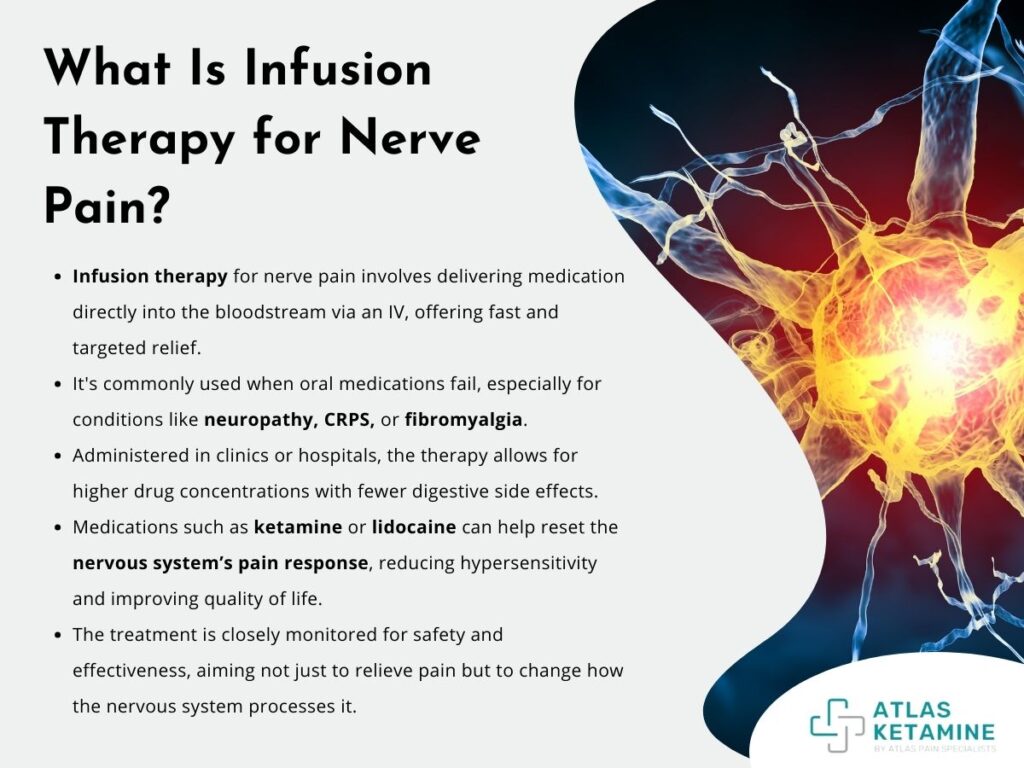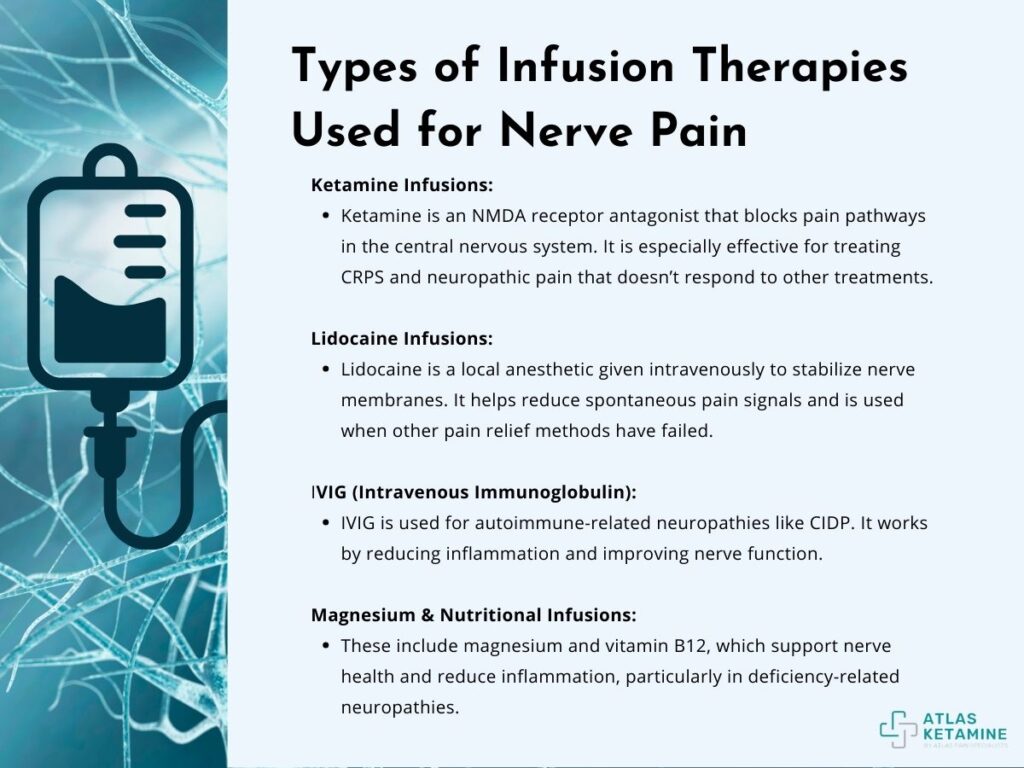Nerve pain can be debilitating, affecting everything from mobility to mental well-being. For those who’ve tried traditional medications without success, infusion therapy offers a promising alternative. This advanced treatment delivers medication directly into the bloodstream, targeting pain at its source for faster, more effective relief.
However, one of the most pressing concerns for patients is the cost. From ketamine to IVIG infusions, prices can vary widely, and insurance coverage is often unclear. In this guide, we'll break down infusion therapy for nerve pain costs covering the types of infusions available, the costs involved, and how to manage expenses effectively.
What Is Infusion Therapy for Nerve Pain?
Infusion therapy is a medical treatment that involves administering medication directly into a vein through an intravenous (IV) line. For individuals suffering from chronic or severe nerve pain—often caused by conditions like neuropathy, complex regional pain syndrome (CRPS), post-surgical nerve damage, or fibromyalgia—infusion therapy offers a targeted and fast-acting method of relief when oral medications are ineffective.

The process typically takes place in a hospital, outpatient clinic, or specialized infusion center. Patients are monitored closely during and after treatment for safety and effectiveness. Infusion therapy bypasses the digestive system, allowing medications to reach the bloodstream quickly and in higher concentrations. This can result in faster pain relief and fewer gastrointestinal side effects.
The goal of infusion therapy for nerve pain is not just to mask the pain, but to alter how the nervous system responds to pain signals. By using medications like ketamine or lidocaine, infusion therapy can “reset” abnormal pain pathways and reduce hypersensitivity, improving the patient’s quality of life.
Types of Infusion Therapies Used for Nerve Pain
There are several types of infusion therapies commonly used to treat nerve pain, each tailored to the patient’s specific condition and medical history:

- Ketamine Infusions
Ketamine is a powerful anesthetic and NMDA receptor antagonist. At low doses, it has been shown to relieve nerve pain and reduce symptoms of depression often associated with chronic pain. Ketamine works by blocking pain pathways in the central nervous system and is especially effective for CRPS and treatment-resistant neuropathic pain. - Lidocaine Infusions
Lidocaine, a local anesthetic, can be administered intravenously to treat widespread nerve pain. It stabilizes nerve membranes and reduces spontaneous pain signals. Lidocaine infusions are typically used when other pain relief methods have failed. - IVIG (Intravenous Immunoglobulin)
Used mainly for autoimmune-related neuropathies, such as CIDP (Chronic Inflammatory Demyelinating Polyneuropathy), IVIG helps reduce inflammation and improve nerve function. It is usually prescribed when nerve pain is caused by immune system dysfunction. - Magnesium and Other Nutritional Infusions
Some patients receive magnesium, vitamin B12, or other nutrients via IV to support nerve health and reduce inflammation, especially in cases of deficiency-related neuropathy.
Each infusion therapy is tailored to the underlying cause of pain, the patient’s response to past treatments, and current health status.
Average Cost of Infusion Therapy for Nerve Pain
The cost of infusion therapy for nerve pain can vary widely depending on the type of medication used, the treatment setting, and geographic location. On average, a single infusion session can cost between $300 and $2,000, but in some cases—especially with specialized drugs like ketamine or IVIG—the cost may exceed $3,000 per session.
Patients often require multiple sessions over several weeks or months. For instance, a full course of ketamine infusions may include six sessions, which could total $2,000 to $10,000 or more. IVIG therapy, which is commonly used for autoimmune neuropathies, can be significantly more expensive, ranging from $5,000 to $10,000 per dose, especially if high doses or long-term therapy are needed.
Additional costs may include:
- Initial consultation and assessment: $100–$300
- Facility fees: outpatient clinics may charge separate fees for monitoring or equipment
- Follow-up appointments: necessary to evaluate effectiveness and side effects
Insurance coverage plays a big role in determining out-of-pocket costs. Some private insurers, Medicare, or Medicaid may cover infusion therapy if it’s medically necessary and well-documented. However, ketamine infusions for pain are often not covered because they are considered “off-label” for that use. IVIG may be covered if the neuropathy has an autoimmune origin.
| Cost Component | Estimated Cost Range | Notes |
|---|---|---|
| Single Infusion Session | $300 – $2,000 | Varies by medication and facility |
| Ketamine Infusion (per session) | $400 – $1,500 | Often requires 6 sessions; total: $2,000 – $10,000+ |
| IVIG Infusion (per dose) | $5,000 – $10,000 | For autoimmune neuropathies; significantly more expensive |
| Initial Consultation | $100 – $300 | One-time fee for assessment |
| Facility/Monitoring Fees | Varies (may be bundled or separate) | Some clinics charge extra for equipment and monitoring |
| Follow-up Appointments | $100 – $250 each | To assess effectiveness and side effects |
| Insurance Coverage | Varies | Ketamine often not covered; IVIG may be covered if medically neces |
Factors That Influence the Cost
Several variables can significantly affect the total cost of infusion therapy for nerve pain:
- Type of Medication: Different drugs have vastly different price points. Ketamine is more affordable per dose but may require multiple sessions. IVIG, on the other hand, is expensive and often used over longer periods. Compounded medications or customized IV cocktails can also increase costs.
- Dosage and Duration: Higher doses or longer infusion times require more medical resources and monitoring. Patients with severe or resistant nerve pain may need ongoing maintenance infusions.
- Treatment Facility: Costs vary between hospitals, private pain clinics, and outpatient infusion centers. Academic hospitals may charge more due to advanced monitoring or specialty staff.
- Geographic Location: Urban centers or countries with higher healthcare costs tend to charge more for infusions. Clinics in lower-cost areas may offer more competitive pricing
- Insurance and Billing Practices: Coverage varies widely between insurance providers. If a therapy is considered experimental, it may not be covered. Some clinics require upfront payment, while others offer payment plans or work directly with insurers.
- Additional Services: Lab tests, medical evaluations, ECGs, or pre-infusion screenings may be billed separately. Patients may also incur costs for transportation, accommodation (for distant clinics), or missed work.
Insurance Coverage and Payment Options
Insurance coverage for infusion therapy for nerve pain can be complex, as it heavily depends on the medication used, diagnosis, and insurance provider policies. In some cases, insurers cover infusion therapy if it’s considered medically necessary and FDA-approved for the patient’s specific condition.
For instance, IVIG therapy used in autoimmune-related neuropathies (e.g., CIDP) is often covered, especially under Medicare Part B or Medicaid, when documented with clinical evidence.
However, ketamine infusions for nerve pain are rarely covered, as this use is considered “off-label.” Although ketamine is FDA-approved as an anesthetic, using it for chronic pain or depression falls outside standard insurance policies. Patients seeking ketamine treatments typically pay out-of-pocket, though some insurers might reimburse a portion under mental health provisions.
To navigate this, patients should:
- Request a pre-authorization from their insurer before treatment.
- Ask for a Letter of Medical Necessity from their physician.
- Clarify if the infusion center bills insurance directly or requires self-pay upfront.
- Explore financial assistance programs provided by pharmaceutical companies or the treatment center.
Some infusion centers offer payment plans, allowing patients to spread the cost over several months. Others may have sliding scale fees based on income. For uninsured or underinsured patients, negotiating cash discounts can reduce the overall burden.
Is Infusion Therapy Worth the Cost?
Determining whether infusion therapy is worth the cost depends on various factors—effectiveness, alternative options, quality of life, and financial flexibility. For many patients with severe, treatment-resistant nerve pain, infusion therapy provides significant relief when oral medications, nerve blocks, or physical therapy have failed.
Patients with CRPS, diabetic neuropathy, fibromyalgia, or autoimmune nerve conditions often report noticeable improvements after just a few sessions. Ketamine, for example, can rapidly interrupt chronic pain cycles and also offer mental health benefits like relief from depression and anxiety.
That said, not all patients respond equally. Some might see dramatic improvement, while others may feel minimal change. The temporary nature of relief for certain patients—lasting weeks to months—means ongoing sessions may be required, adding to long-term costs.
Considering the price tag, it’s important for patients to:
- Assess how much current pain interferes with daily life and productivity.
- Explore non-invasive or lower-cost alternatives first.
- Review feedback and success rates from the chosen infusion center.
- Factor in potential side effects and downtime.
In short, infusion therapy can be life-changing for the right candidate, but requires careful financial and medical consideration.
Tips for Managing Costs
If you’re considering infusion therapy for nerve pain, here are practical strategies to help reduce expenses and manage payments:
1. Shop Around and Compare Clinics
Prices vary significantly between providers. Ask for:
- Full breakdown of session costs
- Package deals for multiple infusions
- Cash discounts if paying out-of-pocket
Some clinics, especially independent infusion centers, offer competitive rates and bundled sessions at a discount.
2. Ask About Financial Assistance
- Patient assistance programs: Some drug manufacturers offer programs that subsidize expensive medications like IVIG.
- Hospital-based charity care: If treated in a hospital system, ask about income-based financial aid.
3. Use FSA or HSA Funds
If you have a Flexible Spending Account (FSA) or Health Savings Account (HSA), infusion therapy costs may be eligible. These pre-tax funds can ease the financial burden.
4. Check for Reimbursement Options
For treatments not directly covered, such as ketamine:
- Request superbills or detailed invoices from the provider.
- Submit claims for partial out-of-network reimbursement.
5. Limit Unnecessary Add-ons
Some clinics offer IV add-ons like vitamins or hydration boosters that aren’t essential for nerve pain. Stick to what’s medically necessary to avoid inflated costs.
6. Plan for the Long Term
Discuss the expected frequency of treatment with your doctor. Ask:
- How long should you expect to undergo therapy?
- Can the sessions be spaced out over time?
- Are there ways to taper off once pain is controlled?
7. Consider Clinical Trials
Check platforms like ClinicalTrials.gov for infusion studies on nerve pain. Participants may receive free treatment as part of the study.
8. Keep Detailed Records
Track all bills, payments, insurance claims, and approvals. This makes follow-ups and appeals easier if insurance initially denies coverage.
Concusion
Infusion therapy can offer meaningful relief for individuals battling chronic nerve pain, especially when traditional treatments fall short. While the cost can be high, understanding your options—such as insurance coverage, financial assistance, and treatment alternatives—can make the process more manageable.
By researching clinics, asking the right questions, and exploring flexible payment plans, you can make informed decisions that prioritize both your health and finances. For many, the investment in infusion therapy is not just about pain relief—it's about reclaiming quality of life and functioning with comfort and confidence again.
